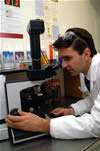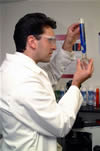Technical Research: Androgen Alopecia (Common Baldness) Mechanism
23 Sep 2009, by in Uncategorized
The miniaturisation and eventual loss of the hair and hair follicle in pre-determined scalp areas, for both men and women, characterises Androgenic Alopecia or Common Baldness. First classified by Hamilton in the 1940s on work with Eunuchs, it is known that Androgens (hormones that promote male characteristics) are an essential factor in the atrophication process.

Normal levels of testosterone (the male sex hormone) in men are sufficient to produce growth of terminal hair in the beard area, atrophy of the hair in certain pre-determined scalp areas, and no effect on hair on the eyebrows and eyelashes. The individual hair follicles are site-specific. In women there is evidence of higher than normal levels of circulating androgens in cases of Androgenic Alopecia.
The genetic influence on these site-specific hair follicles is pronounced, and genetically, Androgenic Alopecia is considered to be an autosomal dominant trait with variable penetration.
To date no specific set of “balding” genes have been identified and no genetic solution has so far been found, although this may eventually represent the most elegant solution to the problem of Androgenic Alopecia.
The individual hair follicles have an intrinsic response to the androgens which promote and amplify the individual follicle’s genetic programming. This site-specific property gives the basis for hair transplant surgery as the genetic code of the individual hair follicle is maintained when the follicle is transplanted to a different part of the scalp.
It is also known that Androgenic Alopecia and beard growth do not reverse and revert back to the pre-pubertal levels if men are castrated after puberty. The gene expression is maintained without the androgen present, once the triggering has occurred.
The specific hair follicle response to androgens requires the presence of intracellular androgen receptors. Androgenic Alopecia is absent in patients with Androgen Insensitivity Syndrome. Patients with 5-alpha-reductase deficiency are also generally thought not to go bald, but the familial influence is not clear and the role of 5-alpha-reductase less certain.
The metabolism of androgens in Androgenic Alopecia is not fully understood. Hair follicles from all body sites are known to metabolise testosterone to the less active androstenedione but higher 5-alpha-reductase activity has been shown in balding hair follicles, compared to non-balding follicles. There are known to be two types of 5-alpha-reductase (Type I and Type II) of which Type I is associated with sebaceous gland and scalp skin activity and Type II with androgen action in Androgenic Alopecia. Conversion of the less active testosterone to the more potent metabolite di-hydroxy testosterone (D.H.T.) triggers the gradual atrophy and eventual loss of the hair follicle.
Androgenic Alopecia Treatment

Anti-Androgens
The blocking of androgen receptors is effective but blocks all androgen activity leading to quite serious side effects on male masculinity and feminisation of the male foetus in pregnant women. However, ‘Cyproterone Acetate’ and ‘Spirolactone’, both anti-androgens, have a stabilising effect on Androgenic Alopecia but do not cause regrowth.
5-alpha-reductase Inhibitors
‘Finnasteride’ (Merck) has been used as a 5-alpha-reductase Type 2 inhibitor, blocking the conversion of testosterone to di-hydroxy testosterone and is administered both orally (the ‘baldness pill’) and as a topical lotion. The progression of hair loss was slowed and some hair growth achieved in men under 40, but cessation of treatment led to progression of balding. Side effects have been reported including reduced libido, and reduced ejaculate volume. Finnasteride must not be used by women of child bearing age since it may cause Hypospadias (developmental anomalies) in a male foetus.
Non-hormonal Therapy
A topically applied non-hormonal therapy, offers the least risk of side effects and the most realistic method to date to slow or reverse the course of Androgenic Alopecia. Treatment systems can be designed for delivery into cells of the hair bulb and considerable research is being undertaken into this type of product. Non-hormonal products have been shown to stimulate the growth of isolated hair follicles in culture in the absence of a blood supply. The mechanism for this type of product is not fully understood and the products are usually derived empirically. A number of these clinically active products are known.
Research Director
The Hair Centre
Do you have Hair Loss Problems, read our Hair Loss Help






Sorry, the comment form is closed at this time.